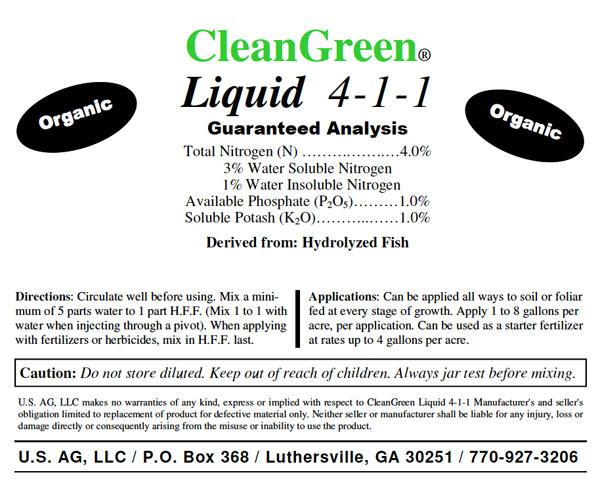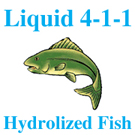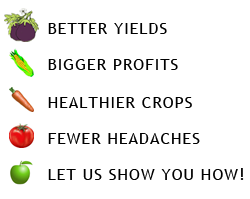Liquid 4-1-1 Hydrolyzed Fish Fertilizer
Liquid 4-1-1 Hydrolyzed Fish Fertilizer
Liquid 411 Brochure – Liquid 411 MSDS - Liquid 411 Label
B.F.-H.F.F.’s main ingredient is fresh menhaden, a marine fish in the herring family. This fertilizer is a unique blend of whole fish and plant protein (seaweed) extracts that have been hydrolyzed, or converted to amino acids using a cold enzyme process. This produces a nutrient rich product.
It is widely recognized that fertilizers derived from fish emulsions and extracts contain chelating agents of various forms which will increase water solubility of various metal cations, increasing availability for plant uptake.
B.F.-H.F.F. helps build the organic matter percentage of soils and improves the nutrient and micro-nutrient balance too. Balanced soils may show increased water and nutrient capacities, better air exchange, and better disease resistance; all of which gets passed on to the planted crops.
B.F.-H.F.F. is an excellent natural fertilizer that’s extremely versatile. B.F.-H.F.F. is screened through #80 mesh screen and is 100% soluble and sprayable. It is compatible with most insecticides, herbicides, and fungicides.
4-1-1 Hydrolyzed Fish Fertilizer
Total Nitrogen (N)…………………………….4.0%
Water Soluble Nitrogen……………………..3.0%
Water Insoluble Nitrogen…………………..1.0%
Available Phosphate (P205)……………….1.0%
Soluble Potash (K20) ……………………….1.0%
Applications and Rates
Legumes (Alfalfa, Soybeans and Peanuts) respond especially well to Hydrolyzed Fish Fertilizer.
Alfalfa – Apply to 4 to 8 gallons H.F.F./acre at start of season (first sign of green in crown or at planting). Can also apply 1 to 2 gallons after each cutting with field sprayer or center pivot.
Row Crops – At planting apply in the row, on the seed 1 to 2 gallons H.F.F./acre. Another option: Before planting broadcast (spray) or incorporate (work in) 4 to 8 gallons H.F.F./acre. Note: H.F.F. can also be added to Clean Green (or any liquid starter fertilizer) and can be sidedressed.
Foliar Feeding or Top-dress – 2 to 4 gallons H.F.F./acre. May be applied as low as 1% to 2% of total solution. Can be used as a carrier for herbicides and insecticides (especially effective when combined with Clean Green fertilizers).
What is Hydrolyzed Fish Fertilizer?
Hydrolysis is the process of transforming a solid material into a water-based solution or suspension. By hydrolytically breaking down the organic components of a fish such as its protein, oil (fat) and bone into extremely small parts, fish hydrolysate, a nutritional product, is obtained. Mostly, the protein, characterized by long molecular chains, is divided into its smaller component such as peptides and ultimately amino acids. The number and types of amino acids and their mix determine the nutritional profile of that hydrolysate. The purpose of breaking down the protein is to make the nutritional elements (amino acids) available for easy absorption. The same process is utilized in the digestive system of mammals to break down food so that the body can absorb it. We talk about “digesting” our food. In fact fish hydrolysate is also referred to as “fish digest”. Our fish hydrolysate is produced utilizing only natural enzymes to break down the long protein chains.
Fish hydrolysate is very different from standard fertilizer products so-called fish emulsions made from fish soluables. Those products are not hydrolyzed. They are produced as a byproduct of the fishmeal manufacturing process. During this process water and dissolved nutrients are squeezed out of the fish before the remaining fish, the press cake, is processed in an oven for final drying. The stick water, i.e., the portion of the fish that was removed by pressing or squeezing the fish is a combination of salt water, water from the fish tissues, fish blood, fish oil/fats and water-soluble nutrients. Since not all amino acids are water soluble, consequently the nutritional profile (types of amino acids and their relative proportion) of the stick water is quite different from the composition of the original source, the fish. Therefore, the stick water composition is limited and inferior to a product utilizing the entire fish with all its amino acids. Fish hydrolysate utilizes whole fish and therefore contains the whole spectrum of fish nutrients.
Here is a brief look at some of the benefits of using hydrolyzed fish:
- Provides the macro nutrients required for healthy growth.
- Provides the micro nutrients required for healthy growth.
- Is easy to apply on the soil or directly on the foliage.
- Improves yields and the quality of agricultural crops.
- Reduces the overall cost of fertilizer, based on yield.
- Use hydrolyzed fish as a pH stabilizer for pesticide sprayer solutions.
Why Organic?
The mission of organic agriculture and home-gardening is to enhance and secure environmental and human health by maintaining the long-term fertility and health of the soil and avoiding any contamination with unfavorable chemical components. The use of the ‘right’ fertilizer and soil conditioner becomes critical in achieving the goals of creating safe foods and optimum plant growth and still following environmentally safe farming and gardening conduct.
In our evermore growing health conscious society organic food products are being more and more recognized for their high quality and freshness, flavor, and in particular their lack of pesticides and other potentially harmful chemicals. Organically grown fruits and vegetables are produced without the standard battery of modern organo-chlorine chemicals that are commonly utilized in conventional produce production.
The most critical problem related to synthetic fertilizers is that they deplete the soil of humus, starting a vicious cycle for the environment and farming practice. A worst case scenario can be described as the following:
1. Humus depleted soil cannot imbibe the water.
2. The water stays on the surface and runs off rather than being absorbed.
3. The run-off water carries away the topsoil
4. The reduced topsoil layer decreases productivity of the farmland.
5. To compensate for the loss in soil productivity the amount of applied fertilizer is drastically increased.
6. The soil loses its ability to absorb and retain moisture resulting in depleting aquifers that gradually collapse.
7. The irreversible loss of water holding ability in turn irreversibly destroys the farmland’s productivity and therefore agricultural use.
Why Long and Slow-release of Nutrients?
Synthetic High Nitrogen Fertilizers boost the risk of insect and disease infestations and cause immense stress on your plants or seedlings. It is easily observed; synthetic fertilizers induce a quick growing rush by making excess nutrients available for a short time. The plant absorbs the chemicals quickly and uses the excess energy for very rapid growth. However, when this boost subsides plant nutrition becomes sub-optimal, until the next boost with high nitrogen, causing an undesirable stress cycle for your plants.
In contrast, organic fertilizers deliver nitrogen as the plant needs it. In general, they are slow releasing, i.e., the nutrients are slowly available. Therefore, it is advised to apply organic fertilizers and soil conditioners several weeks before planting. Inappropriate soil preparation with solid fertilizers may result in clumped and non-rooted solid organic materials that may in turn interfere with seeding operation or cause other problems such as local nutrient deficiencies.
Fish as fertilizer is an old idea and was used already by the native Indians many hundreds of years ago. Liquid 4-1-1BF-HFF Hydrolyzed Fish Fertilizer is 100% natural and organic containing all the essential nutrients plants need for healthy growth. It supplies Nitrogen, Phosphorus, Potassium (NPK) and many trace elements, micronutrients and minerals at a steady state rate compared to synthetic products.
How is this achieved?
The electrical charges associated with proteins promote the ‘clinging’ of the proteins to the negatively charged soil. This prevents the nutrients from being flushed away. Then, microorganisms in the soil convert the organic fertilizer into a form favorable for absorption by the plant roots. This is a slow process, but most importantly the plant is feeding itself naturally. Furthermore, the electrical charges of proteins also promote the chelation of elements and minerals in the soil that would be otherwise unusable for the plant utilization. This complexing with minerals favorably affects soil activity. Overall, humus content and earthworm populations are increased, generating a more balanced soil.




